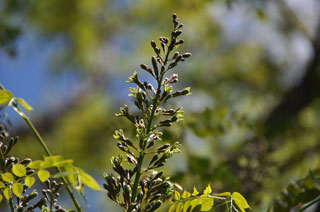KENTUCKY COFFEE-TREE
|
 |
| File Size: 70 KB |
|
|
|
Gymnocladus dioicus (L. ) K. Koch
|
| Riley County, Kansas |
| Height: 30-75+ feet |
| Family: Fabaceae - Bean Family |
| Flowering Period: May, June |
|
| Trunks: | | Short with large branches when growing in the open, long and straight when in woods, diameter 6 to 20 inches; branches coarse; crown open and rounded in open areas, narrow, pyramidal, few-branched in woods; bark of young trees light brown, smooth; bark of medium-aged trees thick, light gray, scales curled; bark of old trees dark gray, thick, shallow fissured, ridges flat. | | Twigs: | | Coarse, stout, brown; lenticels orange; terminal bud absent; lateral buds bronze, in raised, silky craters; leaf scars large, irregularly heart-shaped; bundle scars 3 or 5, large, divided. | | Leaves: | | Alternate, twice pinnately-compound, deciduous, 1 to 3+ feet long, 1 to 2 feet wide; stalk 8 to 16 inches long, stout, glabrous; divisions of the leaf (pinnae) 3-6, each 8 to 16 inches long, with 3-7 pairs of leaflets; leaflets egg-shaped, .6 to 2.8 inches long, .6 to 1.2 inch wide; thin; surfaces light green, slightly hairy; margins entire; tips tapering-pointed; bases tapered or rounded; leaflet stalks short. | | Flowers: | | After leaves, in loose terminal panicles or racemes 3 to 12 inches long, 18-20-flowered; stamens and pistil in same flower or on separate trees; sepals 5, narrow, oblong; petals 5, narrow, oblong, 1/6 to 1/5 inch long, keeled; greenish-white; stamens 10, in 2 series; filaments hairy; anthers yellow; stigma disc-like. | | Fruit: | | Pods, short-stalked, oblong, 3.2 to 10 inches long, 1.2 to 2 inches wide, 1/4 to 1/2 inch thick, straight or curved, purplish-brown; seeds 1-8, circular, 3/4 to 4/5 inch in diameter, flat, hard, smooth, olive-colored; pods ripen in October but remains closed until winter | | Habitat: | | Rich moist woods, stream edges, wooded bottomland, rocky ravines, base of bluffs. | | Distribution: | | East 1/2 of Kansas | | Origin: | | Native | | Toxicity: | | The seeds are toxic when consumed raw. Livestock poisoning can occur when new foliage is eaten in the spring. Symptoms in animals include diarrhea, excess salivation, weakness, and depression. | | Uses: | | Used for fence posts. Native Americans roasted and ate the seeds, used the seeds as counters in games, and crushed the roots and used them as snuff to treat headaches by sneezing or to revive someone who was unconscious. Settlers in Kentucky and Tennessee roasted and ground the seeds as a coffee substitute. | | Comments: | | From Greek gymnos "naked" and clados "branch" alluding to the sparse branches. The leaves turn yellow and drop in early autumn. The wood is strong, coarse-grained, brownish-red, and is very durable. |
|
| Kentucky Coffee-tree flowers |  | | 90 KB | | Riley County, Kansas |
| | Kentucky Coffee-tree leaf |  | | 111 KB | | Riley County, Kansas |
| | Kentucky Coffee-tree bark |  | | 160 KB | | Riley County, Kansas |
| | Kentucky Coffee-tree fruit |  | | 41 KB | | Riley County, Kansas |
| | Kentucky Coffee-tree fruit |  | | 90 KB | | Riley County, Kansas |
| | Kentucky Coffee-tree fruit |  | | 90 KB | | Riley County, Kansas |
| | Kentucky Coffee-tree buds |  | | 40 KB | | Riley County, Kansas |
| | Kentucky Coffee-tree |  | | 131 KB | | Riley County, Kansas |
| | Kentucky Coffee-tree fruits |  | | 43 KB | | Riley County, Kansas |
| | Kentucky Coffee-tree bark |  | | 153 KB | | Johnson County, Kansas |
|
|
|
|












